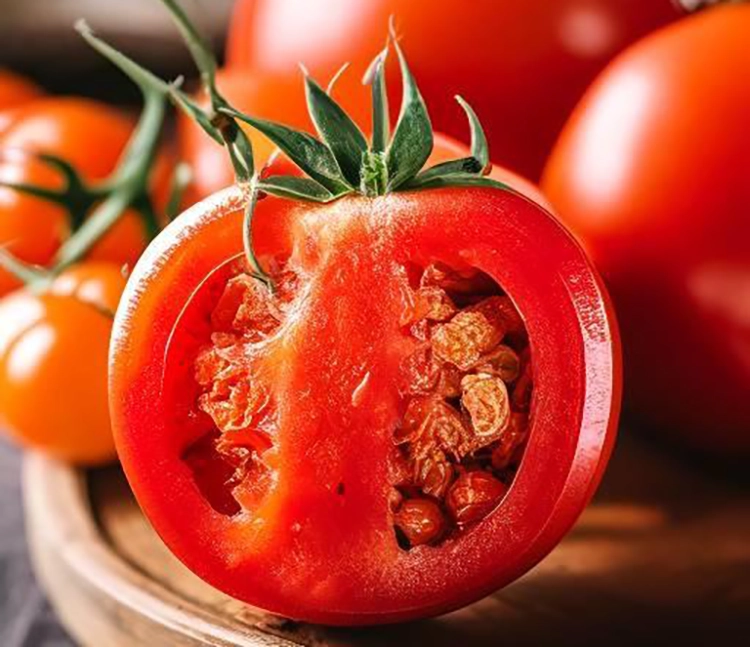We can easily tell the difference between most fruits and vegetables, but when it comes to the age-old question of whether a tomato is a fruit or a vegetable, we’re not sure how to answer it.
Although both fruits and vegetables are part of our recommended five-a-day, there are clear differences between fruits and vegetables.
Whether a tomato is a fruit or a vegetable depends on whether you talk to a botanist who uses the botanical definition, or a nutritionist or chef who uses the gastronomy definition.

Botanical classification: Tomatoes are fruits
Botanists will use botanical classifications based on physiological characteristics of the plant, such as the structure, function, and organization of the plant. Botanically, therefore, “fruit” is the seed product that grows from the ovary of a flowering plant, or the way a plant spreads its seeds.
The fruit of a plant has at least one seed, which grows from the flower of the plant. With this definition in mind, tomatoes are classified as fruits because they contain seeds and develop from the flower growth of the tomato plant.
Botanical terms, on the other hand, do not have a set definition of a vegetable, but rather a catch-all term that covers all other edible parts of the plant: roots, stems, leaves. Therefore, botanically, we classify foods like apples, strawberries, and peaches, including tomatoes, as fruits.

Culinary category: Tomatoes are vegetables
Nutritionists, chefs and even your family use a gastronomic classification system that defines fruits and vegetables based on how plants are used and their flavor characteristics.
As far as cooking is concerned, “vegetables” are usually firmer in texture and bland in flavor, and need to be cooked in dishes such as stews, soups, or stir-fries. “Fruits,” however, are soft in texture and sour or sweet in flavor, and are often enjoyed raw, in desserts, or in jams.
Tomatoes are juicy, sweet and can be eaten raw. However, we also prepare them in savory dishes, which is why we usually classify tomatoes as a vegetable.

Botanical classification VS culinary classification
Why can we categorize tomatoes in two different ways when they confuse us?
Because each of these definitions serves its own purpose. For example, botanical classifications are useful when botanists want to discover the origin of tomatoes, help them identify different varieties of tomatoes, or understand how to grow and harvest all types of tomatoes.
Gastronomic definitions are perhaps more useful for the general public, nutritionists, and chefs, as foods from the same family may not have the same nutritional content.

For example, cantaloupe, watermelon, butternut squash, cucumber, and squash all belong to the same plant discipline, but have different nutrient profiles.
Other botanical fruits that are considered vegetables in cooking are: avocados, olives, squash, sorghum, zucchini, cucumbers, green peas, peppers, eggplant.

Tomatoes are part of the five-a-day
The five-a-day recommendation was first launched in 1991 as a marketing strategy by 25 fruit and vegetable companies in collaboration with the National Cancer Institute.
Five-a-day refers to eating at least five different coloured vegetables and fruits each day to ensure a balanced and nutritious diet. This includes three types of vegetables (about 80g per serving) and two types of fruits (about 160-200g per serving).
Doing so helps maintain cardiovascular health, boosts immunity, antioxidants, prevents disease, and helps with weight control.

In the five-a-day recommendations, tomatoes are classified as a vegetable, which is the definition of cooking, since cooking is how most people learn about fruits and vegetables.
A daily tomato supplement for adults is about one medium tomato or seven cherry tomatoes.
Remember to eat a variety of fruits and vegetables so that you can meet the five-a-day requirement.

Are tomatoes fruits or vegetables?
To sum up, from a technical point of view, tomatoes are both fruits and vegetables.
Despite its botanical status as a fruit, tomatoes are usually prepared in savory dishes, which is why they are often described as a vegetable.
Still, we just need to know that tomatoes are delicious, and who cares about classification, as long as we all agree that tomatoes are easy snacks, delicious in stews, and a healthy option in our diets, providing us with fiber, vitamins and minerals.

Reference source for this article: Is a Tomato a Fruit or a Vegetable and Why?
(Statement: This tweet is for the purpose of transmitting information and knowledge, if it infringes your legitimate rights and interests, please contact us, we will correct and delete in time, thank you!)

